Captain Marvel aka Shazam
Fawcett and Pre-Crisis Eras
Created by Bill Parker and C. C. Beck

NAME + ALIASES:
William "Billy" Batson, Captain Marvel
KNOWN RELATIVES:
Merrill and Jocelyn Batson (parents, deceased), Mary Batson Bromfield (sister),
Ebenezer (uncle, deceased)
GROUP AFFILIATIONS:
The Marvel Family
FIRST APPEARANCE:
Whiz
Comics #2 [1] (Feb. 1940)
Golden Age Captain Marvel (Fawcett Comics)


Some text adapted from Who's Who #4
The character of Captain Marvel was originally named "Captain Thunder." For more about that, read the section about that hero, below.
Twin siblings Billy and Mary Batson were orphaned as infants, and came under the care of nurse Sarah Primm. When a wealthy woman's baby died unexpectedly, young Mary was left in the girl's place while little Billy was placed in an orphanage. (Captain Marvel Adventures #18)
Later, Billy's Uncle Ebenezer took the boy in, but only to gain control of Billy's inheritance. Ebenezer then threw the young boy out onto the streets. Billy made his way by selling newspapers and spent his nights in the warmth of a local subway station.
One rainy night, a mysterious trench-coated figure entied Billy down a special platform where a spectacular train had arrived to carry them into darkness. After a high-speed ride through twisting tunnels, it came to a halt within a subterranean cavern.
Billy followed the man through an ancient hall, past grotesque statues of the Seven Deadly Enemies of Man into a large chamber. There he was greeted by Shazam, an ancient wizard with a long white beard. He sat on a marble throne beneath a massive block of granite held aloft by a single fraying thread.
Shazam explained how he had used his magic powers to battle evil on Earth for more than 3,000 years. Now it was time to select a successor to carry on his fight. At the wizard's command, Billy spoke his name: "Shazam!" and the boy was transformed in a blinding flash of mystic lightning. He had become Captain Marvel, a super-powerful adult clad in a gold-and-crimson costume. The wizard explained that Billy now possessed of the powers of six legendary elders from which Shazam took his name: Solomon (wisdom), Hercules (super-strength), Atlas (stamina), Zeus (power), Achilles (courage) and Mercury (speed).
The wizard then sat back on his throne and was (apparently) crushed to death by the falling granite block. (He was available to be summoned later, for advice.)
Using his newfound abilities, Billy was hired by Sterling Morris for a job at local radio station WHIZ, where he became the city's youngest and most popular newscaster. (Whiz Comics #2 [1])
The "Marvel Family"
Over the years, Fawcett Comics added numerous members to the "Marvel Family," beginning with the "Lieutenant Marvels." When the villainous Dr. Sivana sent henchmen to capture Billy, they inadvertently snared three other boys with the same name: Tall Billy Batson from Texas, Fat Billy Batson from Brooklyn and Hill Billy Batson from Nashville. When all four Billys shouted "Shazam!" in unison, all became "Captain Marvels." The newcomers agreed that there was only one real Captain Marvel, so they became his "second lieutenants." (The four were known for a time as the Squadron of Justice.) (Whiz Comics #21)
In 1941, a boy named Freddy Freeman was maimed by Captain Nazi. Captain Marvel took pity on him and shared his powers, thus creating Captain Marvel Jr. (Whiz Comics #25) Note: Captain Nazi first appeared in Master Comics #21 (Dec. 1941).
The next year, Billy was finally reunited with his long-lost twin sister, Mary Bromfield, who also shared his power and became Mary Marvel. (Captain Marvel Adventures #18)
Hoppy was a bunny who lived in Animalville, a world of talking animals. He read Captain Marvel's comic book adventures and when his girlfriend Millie was endangered, he tried the magic word and became Captain Marvel Bunny. (Fawcett's Funny Animals #1)
Mary's secret was discovered by a fat fellow named Dudley who pretended to be her uncle — and even dressed up and feigned super-powers as Uncle Marvel. Mary and the others were amused by him and let him hang around. (Wow Comics #18)
Arch Foes
The villainous Black Adam shared the lineage of the power of Shazam (and costume design of Captain Marvel). He came from ancient Egypt to modern times. (The Marvel Family #1) Note: It's worth noting that this was Black Adam's only Golden Age appearance!
Captain Marvel's most persistent foe was Doctor Sivana, who had a rival family to the Marvels. Two of them — Sivana Jr. and Georgia — were as evil and ugly as their father. The other two — Magnificus and Beautia — were beautiful and good. Notes: Sivana first appeared in Whiz Comics #2 [1] (Feb. 1940); Beautia (who took a shine to Cap) in Whiz Comics #4 [3] (Apr. 1940); Magnificus in Whiz Comics #15 (Mar. 1941); Georgia in Mary Marvel #1 (Dec. 1945); and Sivana Jr. in Captain Marvel Adventures #52 (Jan. 1946).
the "Monster Society of Evil" saga is one of Captain Marvel's best remembered adventures. It ran for two years (through Captain Marvel Adventures #22–46 , 1943–45) and involved nearly every member of his rogues gallery. The Society was led by the diabolical telepathic worm from Venus, Mister Mind.
The last Golden Age appearance of the Marvel Family was Whiz Comics #155 (June 1953), when Fawcett relented to legal pressures from DC and chose to simply cease publishing its comic books. (By this time, the industry had also become far less profitable.)
» SEE ALSO: Read more about these golden years — including the reasons for Fawcett's end — in An Oral History: The Fawcett Years
"Split!"
After Fawcett Comics ceased publishing super-hero comic books, a rogue publisher used the name "Captain Marvel" for an all new hero in 1966.
» SEE:
- Learn about the off-brand Captain Marvel of M.F. Enterprises
- Read all about the post-Fawcett era in An Oral History: The Lost Years
Captain Marvel Comes to DC Comics
Twenty Years Later... Shazam! (1973)





When DC Comics brought Captain Marvel back to life, they explained that the Marvel Family had been trapped in suspended animation since 1954. They were attending a public ceremony in their honor, when Dr. Sivana and his evil children struck.
Sivana had invented Suspendium ray, an element that could induce suspended animation. But a clumsy move by Sivana Jr. thrust the villains' spaceship into the sphere of Suspendium, too.
They remained immobile for twenty years until the sphere of Suspendium drifted close enough to the sun to vaporize it. Captain Marvel freed his friends and returned to Earth, they found that most of their friends (including Uncle Dudley, Joan Jameson, Sterling Morris, Cissie Sommerly, Ma and Pa Potter, Prof. Edgewise, Beautia and Magnificus Sivana and Mr. Tawky Tawny) had also been suspended during this time.
The Sivanas had escaped and returned to their mountain hideaway to perfect his death projector, but Cap quickly found him and sent him to face justice. (Shazam! #1) Notes: In the letter column of Shazam! #9, C.C. Beck said their home city was never named, but generally agreed to be New York. In Shazam! #22, it declared that Billy, Mary and Freddy were 14 years old and that Billy lived in an apartment in Pa and Ma Potter's boarding house.
Tawky Tawny became a tour guide at the local museum. Just as he was talking about the evil Mister Mind and the Monster Society of Evil, the building rumbled and fell to pieces. Mr. Mind had absconded with his glasses and voice amplifier and commanded an army of insects to destroy the building's foundation. Mind launched a missile attack but Cap swiftly returned the worm to prison. (#2) Later Tawny was captured and subjected to a catnip potion which caused him to lose control of his animal impulses. (#7)
Cap met a new friend, Sunny Sparkle, "the nicest guy in the world," who seemed to have a power to make people more pleasant and giving. (#2)
Sometimes Billy struggled to understand contemporary culture, things like dance crazes and slang. He asked the wizard to make him look his real age, but was warned that it would affect Captain Marvel's age, too. Billy went ahead and grasped a mystic hourglass and was transformed into a full grown man. But the next time he needed Cap's abilities, he found that his alter ego now possessed the body of a teenager — and couldn't control his powers! He ultimately chose to reverse the change. (#3)
In time, many of Marvel's old enemies resurfaced. Stanley Printwhistle, aka Ibac, had gone straight despite the encouragement of his infernal patrons. (#4) And Aunt Minerva returned with another campaign for Cap to become her sixth husband. (#10) The vengeful Prof. Gilbert Thorne returned to replace a civic statue with one of the Seven Deadly Sins. (#16) Note: Ibac first appeared in Captain Marvel Adventures #8 (Mar. 1942); Minerva in Captain Marvel Adventures #59 (Apr. 1946); Thorne in The Marvel Family #50 (Aug. 1950).
Jarl 499-642-831 came from the year 2349, a reporter for Batson's own Amalgamated Broadcasting System. They worked a case about Dr. Thomas Kilowatt, who invented a "Midas machine" that started turning the whole world into gold. (#12)
Mister Mind reappeared inside Georgia Sivana's apple and restarted the Monster Society with Sivana and Ibac. They challenged the Marvels to a duel and plotted to use Mind's new death ray. Only Sivana escaped round one of this contest; he then accidentally created a society of real monsters, all bearing his own likeness. (#14)
» SEE ALSO: An Oral History: The Shazam Years
Shazam! on Television

When the live action Shazam! television series debuted in the fall of 1974, the comic book was bumped up to 100 pages beginning with issue #15 (it carried an ad for the show as well). The tone of the series remained the same.
This issue featured Captain Marvel's first meeting with Superman. Lex Luthor (who came from "another dimension"/Earth-One) had invented a magic accumulator that reacted to a Shazam! comic book. It transported Luthor to Earth-S, where he witnessed Captain Marvel in action. Luthor teamed up with Mister Mind, whom he also recognized from the comics. They trapped Billy underwater for a time but Luthor was ultimately forced to retreat. As soon as Lex arrived back home, Superman was there to capture him. (#15)
Notes: Shazam! #15 also began a series of text features called "Legends of Shazam," in which each of Cap's six super-benefactors is described in detail. In the letter column of Shazam! #17, editor Julius Schwartz responded to a fan with an official designation for the Fawcett Earth: "It would be too confusing to have two Earth-Ones, so maybe we should call the SHAZAM planet Earth-S."
In 1975, the book shrunk to 36 pages with issue #18, despite the fact that the television series was still on the air, and Shazam! #21–24 featured only reprint stories.
Captain Marvel's new foe was the pointy-eared Zazzo, who came from a magical dimension (similar to Mr. Mxyzptlk). Zazzo channelled Shazam's magic lightning into himself and became a reverse-colored version of Cap. But when Freddy Freeman called out "Captain Marvel!", Zazzo's were withdrawn. Zazzo's father then arrived to escort him home. (#19)
After one Miss Bridges implicated Maxwell Zodiac for being Captain Marvel, Sterling Morris assigned Billy to uncover the hero's secret identity. Billy, Mary and Freddy found that Zodiac had indeed also been granted super-powers by the magic lightning — at the same time as Billy had. Zodiac split himself in three and manifested mostly-innocuous champions to challenge the Marvels. When he was struck again by the magic lightning, he recombined and flew away. (#20)
A New Direction


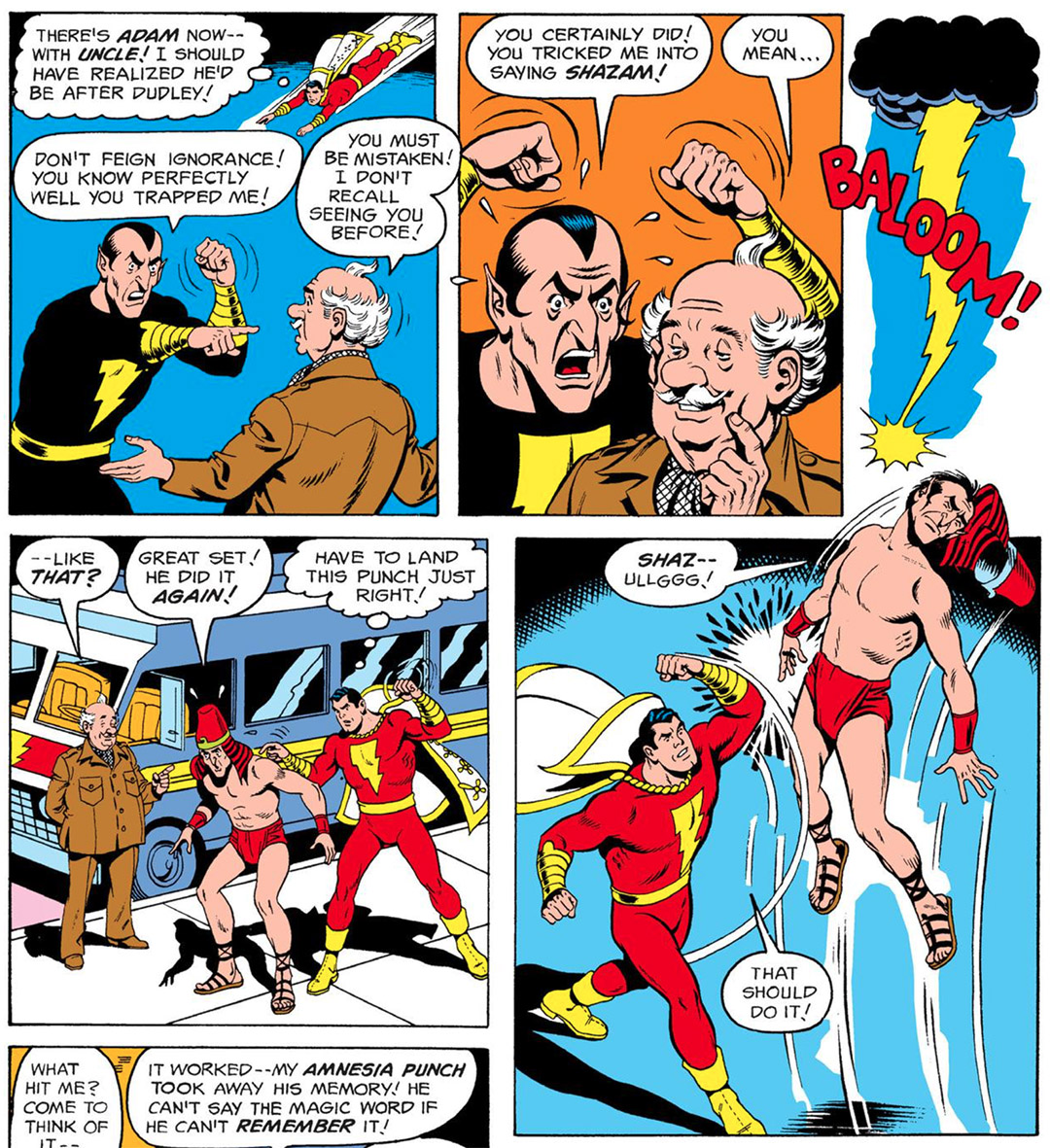
In the fall of 1976, the Shazam! series was retooled. After a brief pause in publishing, during the television series' third season, the comic began sporting a special DC logo. Shazam! #25 was "A DC TV Comic" and the cover featured Cap's TV costar, Isis. This heroine was starring in her second season on television, and like the Marvels was empowered by a goddess. By day, Isis was Andrea Thomas, who acquired the amulet and scroll of Queen Hatshepsut in Egypt. These artifacts gave her the powers of nature and of animals. Isis and Captain Marvel teamed up to save her friend from danger. Note: Isis starred in her own comic series for 8 issues (1976–1978).
More Fawcett characters were introduced into the DC multiverse in a three-issue crossover with the Justice League. (Justice League of America #135–137) Writer Len Wein was restoring lots of "forgotten" characters, from DC's Golden Age, genre features and Quality Comics (whose characters DC acquired in 1956). The JLA and Justice Society joined the Marvels, Bulletman, Bulletgirl, Ibis, Mister Scarlet, Pinky and Spy Smasher to fight the Golden Age King Kull (first appearance, Captain Marvel Adventures #125, Oct. 1951).
The next several issues of Shazam! followed Billy on a special assignment. Sterling Morris sent Billy to report from a tour across America and Uncle Dudley was his driver. Shazam arranged it so that Billy could call upon his divine patrons at any time… using the Eterni-Phone. They set out in a souped up van for Washington, D.C., where, coincidentally, Doctor Sivana had just made the Capitol building disappear. Billy rang up Hercules for his expertise; the demigod told him that the building hadn't moved in space, but 100 million years into the past. Cap traveled via the Rock of Eternity to restore the landmark. (Shazam! #25–26)
Billy and Dudley's path followed Sivana to Philadelphia, where the mad scientist used a reincarnation machine to recreate Blackbeard and other historical villains. The god Mercury also sent Kid Eternity and Mr. Keeper to help Cap by summoning their own army from the past. (#27) Soon after this, the Marvel Family discovered that Kid Eternity was actually Freddy Freeman's long-lost brother. (World's Finest #279) Note: Kid Eternity was originally a Quality Comics character who'd clearly been inspired by the original Marvels.
In Boston, Sivana used his reincarnation machine to bring back Teth-Adam. When the Egyptian emerged from his coffin, he uttered "Shazam!" and became Black Adam again. Adam destroyed Sivana's machine and bolted for the Rock of Eternity. After another round trip to the past, Dudley tricked Adam him into saying "Shazam," and Marvel knocked him out with an "amnesia punch" so he would not remember to say it again. (Shazam! #28)
Sivana next tried to pit Ibac against Captain Marvel, but Ibac's alter ego, Stanley Printwhistle, was trying to reform and he caused Sivana to be captured at last. (#29)
Even prison could not stop Sivana from inventing new menaces. After reading about Superman in Action Comics, he created a robot brain to create his own "man of steel." His android was called Joe Magarac, after a legedary Serbo-Croatian hero who was made of metal. Sivana made an army of robots, which Cap fought the entire Marvel Family, including the Lieutenant Marvels. (#30)
Billy's working tour was no quieter with Sivana out of the picture. In Columbus, Ohio, Mister Mind unleashed the Rainbow Squad, an army of six women whose powers aligned with Shazam's (Dauntless for courage, Sibyl for wisdom, Dynamoll for atomic radiation, Virago for strength, Gibralta for her light aura, and Celeritas for speed). As luck would have it, Dudley and Billy had just reconnected with Jack Weston, the man behind the Minute Man! He helped them overcome the Squad and expose Mr. Mind. (#31) Note: Minute Man first appeared in Master Comics #11 (Feb. 1941).
Mister Mind plagued Cap in two more cities. In Detroit, Billy met Tawky Tawny, who tried out for the Detroit Tigers baseball team. (#32) In Indianapolis, the worm reconstructed Mister Atom as a race car called the "Atomobile." (#33) Note: Mister Atom first appeared in Captain Marvel Adventures #78 (Nov. 1947).
Captain Nazi cropped up in Chicago, stoking terrorist fervor. When the Marvels were in suspended animation, he had set plans in motion and then put himself in stasis as well, so he could awaken when they were free again. Billy called Captain Marvel Jr. for help in bringing him down. (#34)
Billy and Freddy were attacked in New York by King Kull, who sent them back in time. They encountered Mary at a time before their first meeting, and even prompted her to access her powers — proving that she had gotten Shazam's powers at the same time as Billy, but didn't know it. King Kull was attempting to turn time back to his own era. He lured the Marvels into Hell to battle monsters of legend like the Furies, Typhon, Echidna, and Satan himself. The heroes smashed Kull's machine and reversed the time effects. When they returned to station WHIZ, they learn from Mr. Morris that he has had to sell it to Ebenezer Batson, Billy's real uncle, who stole his inheritance. (#35)
World’s Finest Comics
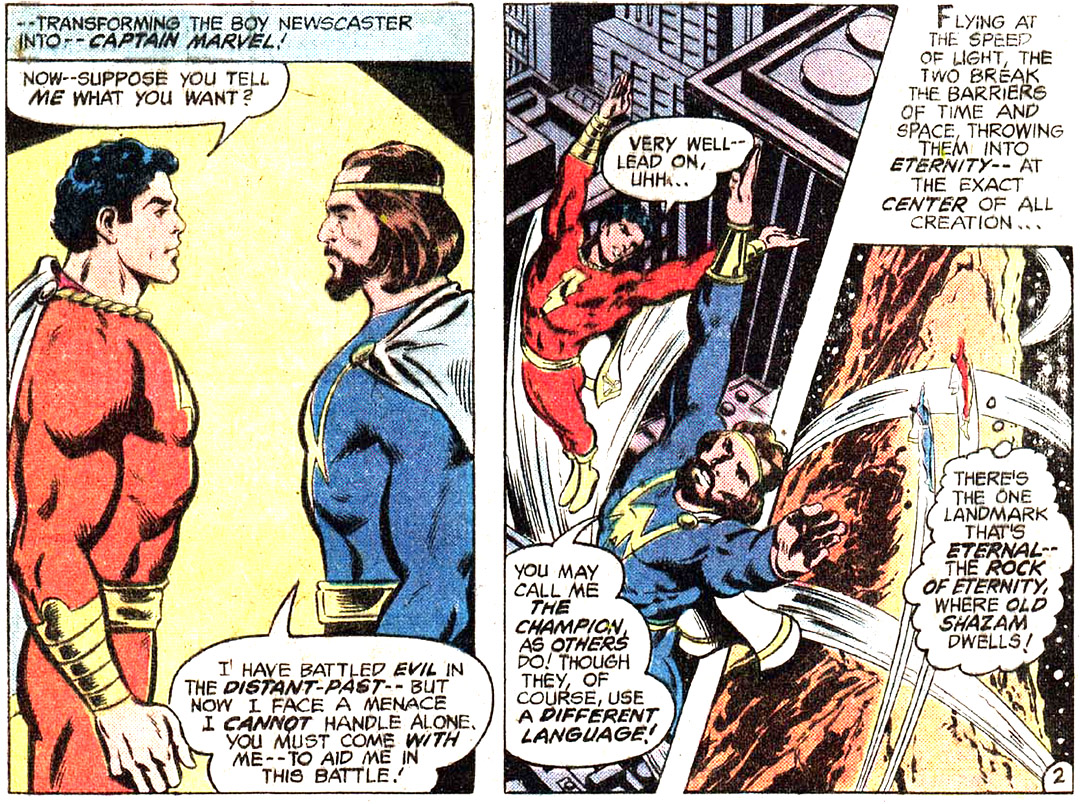
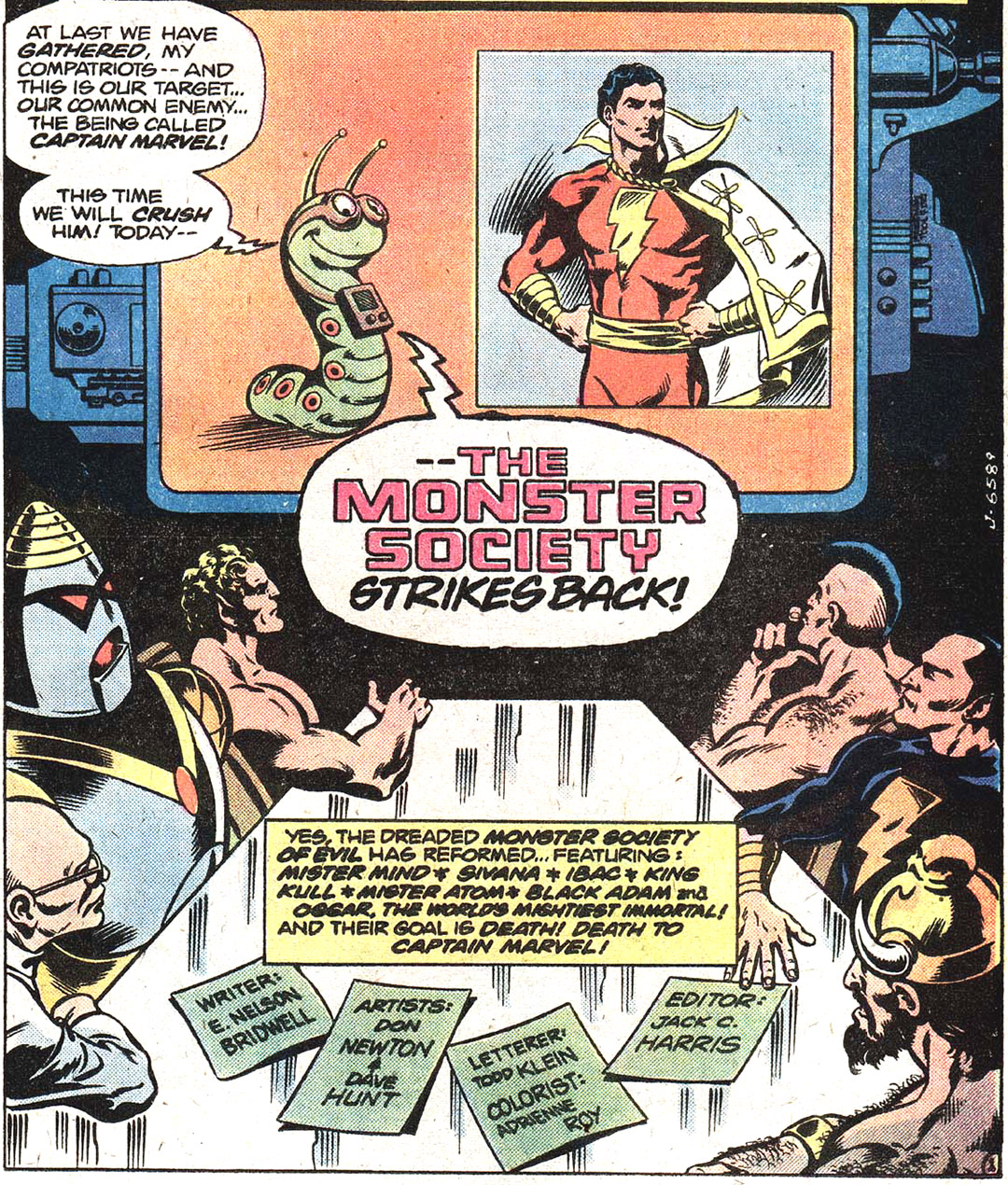
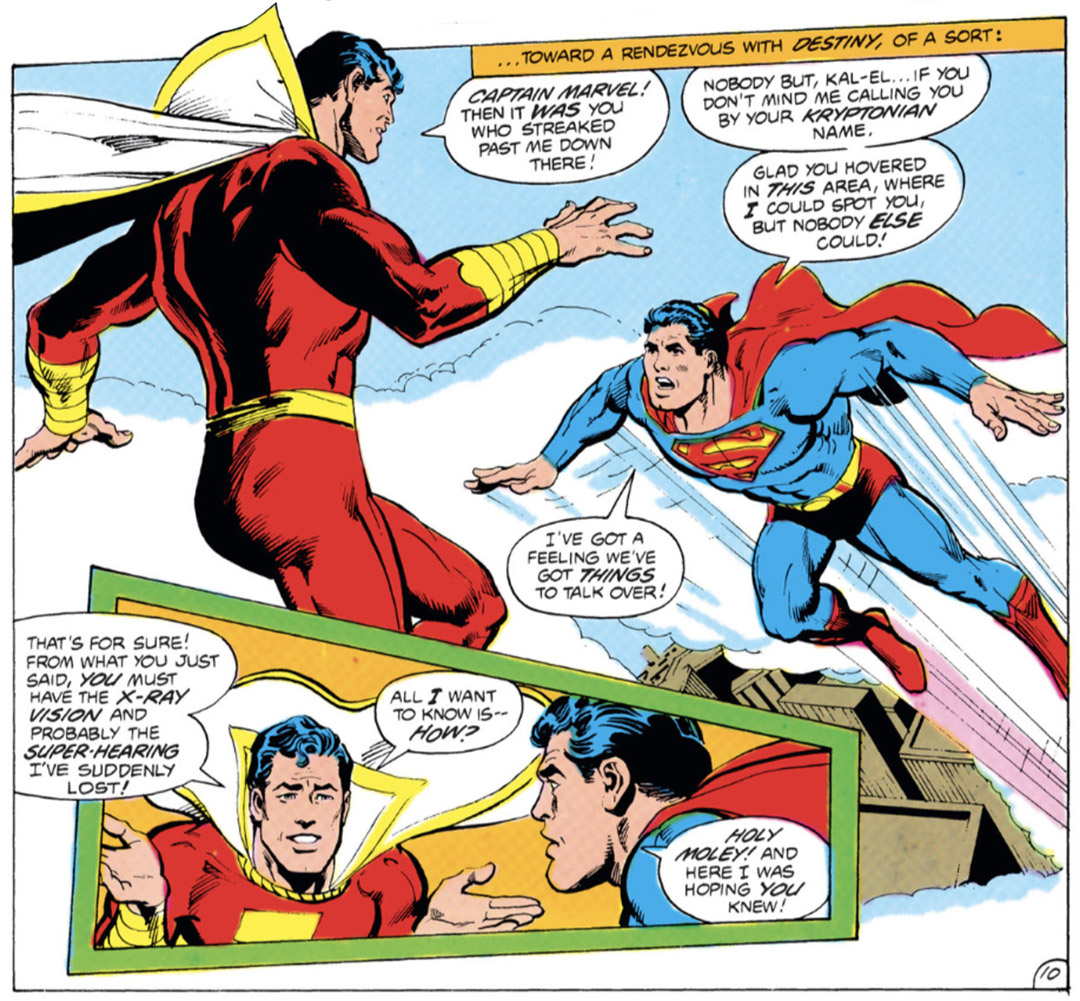



After the cancellation of Shazam! in 1978, Captain Marvel found a home in the newly-expanded World's Finest Comics. Artist Don Newton had taken over and his style gave the feature a more adult tone.
Captain Nazi returned and used a mind control device invented by Sivana to try to bend the world to his Aryan will. (World's Finest Comics #253, 258)
Billy's uncle Ebenezer had made a deal with Satan for financial gain, so he was now in need of Captain Marvel's help to free himself from the bargain. Ebenezer agreed to restore Billy's inheritance if Captain Marvel would help him. Marvel defeated six infernal champions and the devil retreated. Ebenezer signed over his holdings to Billy, who used the money to buy station WHIZ from Sterling Morris. (#254)
Captain Marvel faced lots of new foes during this chapter of his career. The performer called Dreamdancer bewitched both Billy and Jim Barr (aka Bulletman), leaving Mary and Bulletgirl to challenge her. She was defeated when the ladies tricked her into performing her hypnotic dance backward, and the men were released. (#255)
Nate Dallas was cursed by a deal made with the Gamester, an alien who took human lives in exchange for Dallas' gambling wins. Cap revealed the Gamester as a charlatan from the year 2347, who actually knew the fates of the people he was "killing." (#256) Note: This story named Billy's parents: Merrill and Jocelyn Batson.
Captain Marvel befriended a town full of mythic misfits who'd been forced from their ancient homes. Centuars Dion and his wife Hydia, Sylvius the Satyr, Phylla the siren, Pythia the Lamia, and Melissa the mermaid came out of hiding to help save their town from a natural disaster, and were then welcomed by the townspeople. (#260)
Another new menace was the Graybeard Gang, led by its namesake, who had lived over 100 years thanks to a gas from an Egyptian tomb. (#263)
Billy was surprised by a visitor from 7,000 BCE, the first 'champion of the gods.' This hero brought Captain Marvel to his past, where he revealed that his powers accessed by the word "Vlarem" — of Voldar, Lumiun, Arel, Ribalvei, Elbiam and Marzosh. Together they defeated the "three-form monster," Sin, Terror and Wickedness (from The Marvel Family #7, Dec. 1946). A nearby space mountain was used to imprison them and this became the Rock of Eternity, at the center of the universe. Before Marvel returned home, the Champion transformed and revealed that he too was a boy — the wizard Shazam himself! Shazam performed his role for 3,000 years, until his gods were forgotten. (#262)
Mister Mind finally made good on recreating a new Monster Society of Evil, reforming it with all Captain Marvel's greatest foes: Dr. Sivana, Ibac, King Kull, Mister Atom, Black Adam and Oggar. (#264) Marvel responded by rallying his own troops. Not even an alien army amassed by Sivana and Ibac could best the powers of Shazam. (#265–266) The whole Marvel Family (including the Lieutenants) defended the Rock of Eternity from the the Monster Society. (#267)
In 1981, Thaddeus Sivana was awarded the Nobel Prize for Physics. Ironically, his death ray was now used to kill pests; another invention kept cities pollution free; and another created food from rocks. Sivana hated the idea, but when Cap bathed Sivana in rays of kindness and peace, Sivana welcomed the award. (#273)
Satan returned a few more times, granting power to villains to do his bidding on Earth. He created the Darkling from Dora Keane. Her darkness prevented the magic lightning from touching the Marvel Family. (#278) Darkling returned alongside Satan's other protégés (Ibac, Sabbac and Master Man), who attacked Billy and the others while they were on vacation in the mountains. (Adventure Comics #491–492) Note: This "Master Man" was a foe of Kid Eternity, first appearing in Quality Comics' Kid Eternity #15 (1949), but there was also a short-lived Fawcett hero with that name.
Kid Eternity secretly helped the Marvels several times, by sending helpers from the literary and historical past. He finally revealed that he was Freddy Freeman's long-lost brother. (World's Finest Comics #280) Eternity and his pal Mister Keeper were key in helping when Mister Mind returned. (#281)
When the 5th-dimensional Mr. Mxyzptlk (working with Mr. Mind) swapped Captain Marvel for Superman, the Man of Steel ventured back to the Rock of Eternity to find Cap. Later, Clark Kent went for dinner with Billy Batson at Mrs. Potter's. (DC Comics Presents #33) Mary Marvel, Captain Marvel Jr. and Uncle Marvel joined this case, in which Mxyzptlk called forth a legion of cartoon rabbits. One was Hoppy, who joined the fight as Captain Marvel Bunny in time to save the others from King Kull. Mxy ultimately clashed with Mister Mind and returned home of his own accord. (#34)
Crisis on Infinite Earths
During the great Crisis caused by the Anti-Monitor, the Marvel Family appeared when Earth-S was succumbing to the anti-matter wave. (Crisis on Infinite Earths #6) Harbinger spent her power to save it, then Earth-S began to merge with Earths-One, -Two, -X (Quality Comics), and -4 (Charlton). Captain Marvel was a soldier in the final battle against the super-villain army. (#10) Eventually he discovered that he could no longer return to Earth-S. (#11)
The Crisis ended the original continuity of Captain Marvel. The character was reinvented for post-Crisis continuity first by Roy Thomas, then again by Jerry Ordway. Read more!
Since then, various creators have invoked the nostalgia of Fawcett Comics in non-canonical stories. These include:
- Shazam! Power of Hope (2000)
- Shazam! The Monster Society of Evil (2007)
- The Multiversity: Thunderworld Adventures #1 (2015)
- Convergence: Shazam (2015), which looked at life after Earth-S
Captain Thunder


Fawcett Comics
The original name for Captain Marvel was "Captain Thunder." When Fawcett's founder Bill Parker created Captain Thunder, Fawcett rushed out black-and-white "ashcans" to try to secure the trademarks on his signature comic book title. The first ashcan was titled Flash Comics, and another as Thrill Comics. The character wasn't named on the covers, but he was in the first panel of the story inside. Neither of these magazine titles turned out to be viable, so when Cap first appeared on newsstands, it was in the pages of Whiz Comics (numbered issue 2).
In Whiz Comics #2 [1] (Feb. 1940), the hero had been renamed to Captain "Marvel." Several accounts in the The Fawcett Companion (2001) address this matter. Writer Otto Binder presumed that Fawcett's founder, Bill Parker, named the character Captain Thunder, but that "It might also have been [C.C.] Beck himself who suggested Marvel instead."
Ralph Daigh, Fawcett's Editorial Director, said plainly, "As to why the name of our hero was changed from Captain Thunder to Captain Marvel, I just thought it sounded better." But artist Pete Costanza recalled, "When the character's name was being changed from 'Captain Thunder' I suggested 'Captain Marvelous' instead. This was shortened to 'Marvel,' so I can't take all the credit.'"
Fiction House published a character called "Captain Terry Thunder," for its Jungle Comics #1 (Jan. 1940). It is not known whether this influenced Fawcett's decision to change the name.
DC Comics


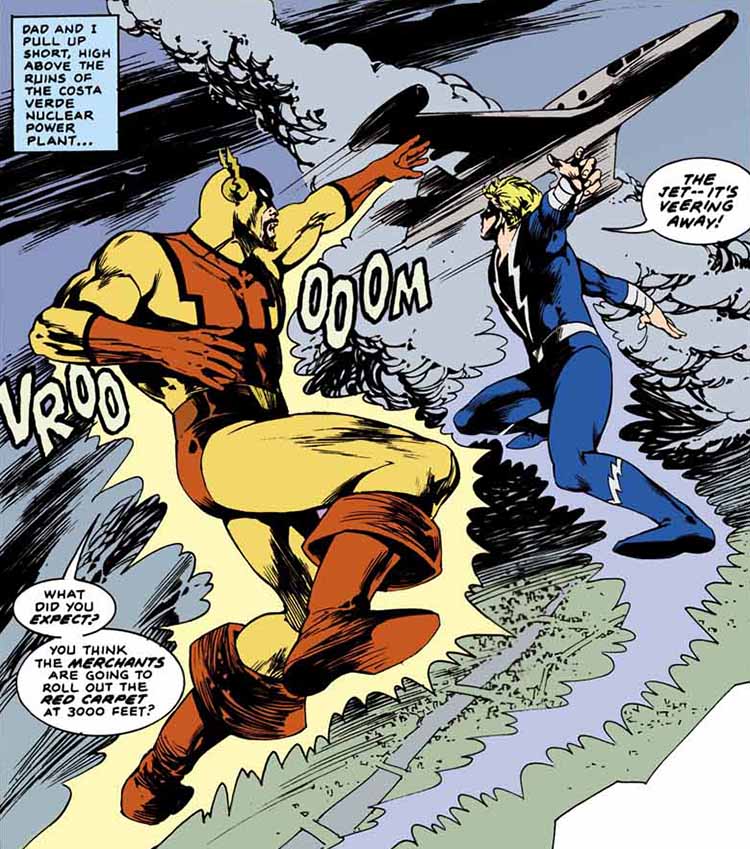

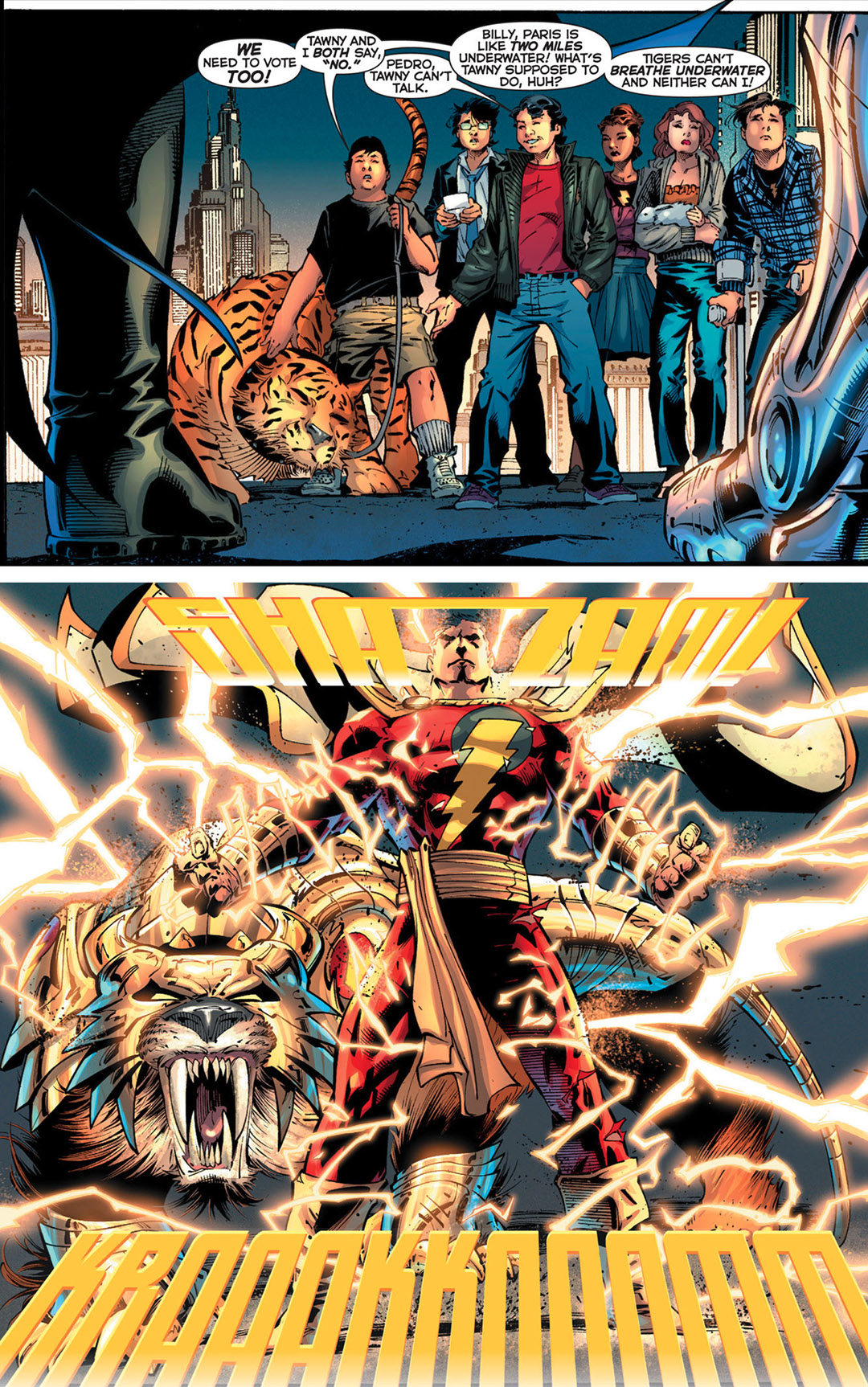
Willie Fawcett
Over the years, this history has inspired the creation of other characters called "Captain Thunder." The first came just a year after Captain Marvel returned to comics at DC. Shazam! writer Elliot Maggin introduced a lookalike called Captain Thunder in the pages of Superman #276 (June 1974).
This Captain was also from a parallel Earth. Thunder's alter ego was Willie Fawcett and he became stranded on Earth-One after an encounter with his enemies, the Monster League of Evil. Willie arrived in Metropolis and soon met Superman, uttering the word "Thunder!" to transform into a super-hero. Like Billy Batson, Willie had met a medicine man of the Mohegan tribe named Merokee. Before "passing on," Merokee bestowed the boy with seven supernatural powers: those of the Tornado, (power) Hare (speed), Uncas (bravery), Nature (wisdom), Diamond (toughness), Eagle (flight) and Ram (tenacity). Captain Thunder's uniform was nearly identical to Captain Marvel's, but featured a sunburst symbol instead of a lightning bolt.
Captain Thunder's recent battle had turned him evil and so he clashed with Superman, fighting to a stalemate. Superman tricked him into changing back into Willie then devised a plan to get Captain Thunder to access his wisdom powers and come to his senses. This wisdom led Thunder to calculate his path home; he uttered "Thunder!" one last time and disappeared. (Superman v.1 #276) Note: At this time, Superman had not yet met Captain Marvel from "Earth-S."
Roy Thomas' Captain Thunder
In 1985, Elliot Maggin created a "sequel" to that story with artist Alex Saviuk. It was penciled but never published, most likely because Roy Thomas had his own plans to use the name (and DC's Crisis on Infinite Earths set the stage for the reshaping the Marvel Family for a new universe). Roy, with Dann Thomas and Dell Barras created an all-new Captain Thunder and his son, Blue Bolt. A dozen issues of Captain Thunder and Blue Bolt were published by Heroic Publishing from 1987–1992. Roy and Dann Thomas currently hold the trademark of the name.
JLA: Destiny
In John Arcudi and Tom Mandrake's JLA: Destiny (a Prestige format series, 2002), they reinvented some Quality Comics characters and included a Black version of Cap named "Captain Thunder."
Flashpoint
The Flashpoint version of Cap was also called "Captain Thunder." This was a proto-version of the New 52 Shazam — six teens and a tiger who together could summon a singular champion. The alternate reality of Flashpoint led into the creation of DC's New 52 continuity.
Powers
Captain Thunder derives his powers from his magic belt buckle. By rubbing the buckle and exclaiming the magic word "Thunder!", young Willie Fawcett becomes Captain Thunder. Captain Thunder has possesses he qualities of seven native spirits: Tornado (immeasurable strength), Hare (super-speed), Uncas (bravery), Nature (wisdom), Diamond (invulnerability), Eagle (flight) and Ram (tenacity).
He could also use his magic word to break the space-time barrier and travel to other dimensions.
DC Appearances of Captain Marvel (pre-Crisis)
» FEATURED APPEARANCES:
- All-Star Squadron #36-37, 51-52 (1984–85)
- Adventure Comics #491-492 (1982)
- All-New Collectors' Edition #C-58 (1978)
- Crisis on Infinite Earths #6, 7, 10, 11 (1985–86)
- DC Comics Presents #33, 34, 49, Annual #3 (1981–82)
- Justice League of America #135-137 (1976)
- Superman v.1 #276
- Who's Who in the DC Universe #14 (1986)
» SERIES:
Fawcett:
- Whiz Comics, 155 issues (1940–53)
- Special Edition Comics #1 (1940)
- Captain Marvel Adventures, 150 issues, (1941–53)
- America's Greatest Comics #1-8 (1941–43)
- Marvel Family, 89 issues (1945–54)
- Mary Marvel, 28 issues (1945–48)
DC:
- Shazam!, 35 issues (1973–1978)
- World's Finest Comics #253–270, 273–282 (1978–81)